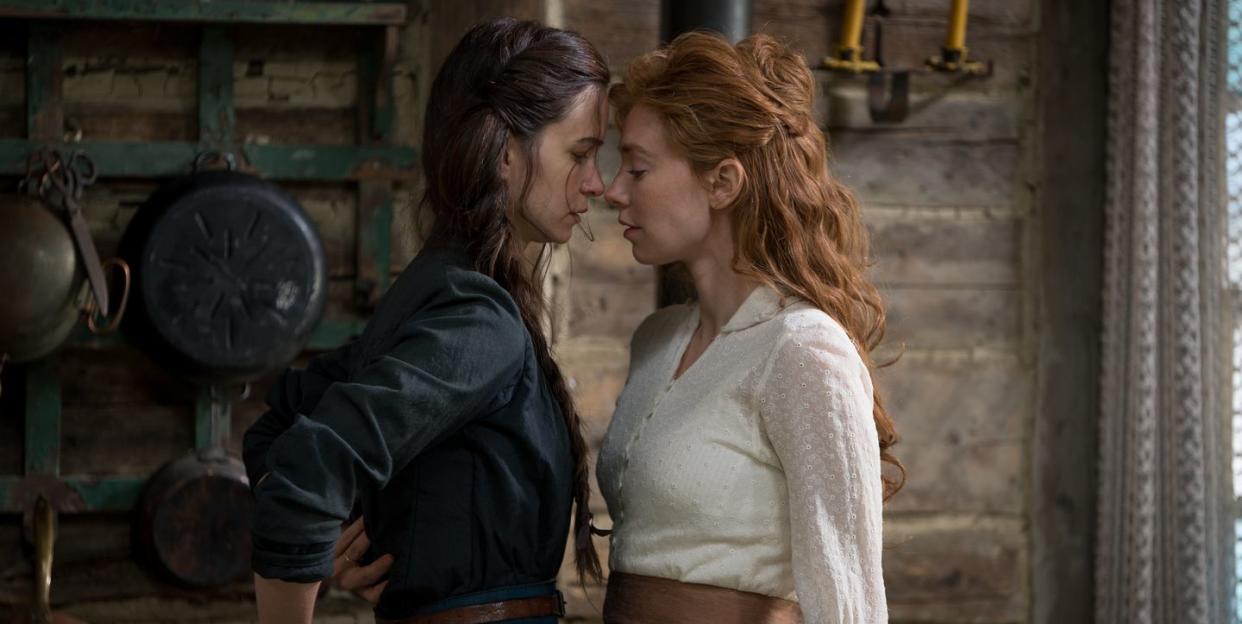The World to Come and the New Wave of Queer Period Pieces

It’s a cast iron law of film reviewing that if you’re writing about a lesbian historical drama you must always refer to it as “ravishing.” Todd Haynes’s Carol? “Ravishing.” Yorgos Lanthimos’s The Favourite? “Royally ravishing.” Céline Sciamma’s Portrait of a Lady on Fire? “Simply ravishing from start to finish!”
With Portrait of a Lady on Fire, the recent Ammonite, and now The World to Come—available on streaming platforms March 2—we may be reaching peak “ravishing.” It’s an old trope of journalism that three makes a trend, so the release, in quick succession, of this trio of sapphic period movies feels like a study in cinema’s endless ability to find a formula and milk it. Twitter has been predictably salty. “Why is every lesbian movie just a supercut of women’s fingertips grazing near the sea,” tweeted the writer Jill Guttowitz, after watching the trailer for Ammonite.
And it’s true that after a while these movies can all blend into the same wash of stolen glances, furtive fumblings, and the complicated business of untying the stays of a corset.
There is more fingertip-grazing in The World to Come, sandwiched between extreme hog-killing, a molasses-and-lard enema, and a blizzard of historic proportions. Directed by Mona Fastvold, it’s a gorgeous, painterly movie, set in 1850s upstate New York, with beautifully modulated performances from Katherine Waterston and Vanessa Kirby as lovers destined to be thwarted by the men who control their lives. The tension, of course, as in all queer period movies, comes from the necessity for secrecy in a deeply hostile world. If only they’d known that 150 years later their pastures would be owned by a lesbian artisanal goat cheese co-operative with an endorsement from Martha Stewart.

“We’re just beginning to realize that we’ve mined a very narrow view of the past and there are a lot of other people whose stories should be told,” says Waterston. “We get where we’re going in the world because people can imagine something more. That’s what every great social movement has been. It starts with someone with the imagination to think of another way to be.”
It’s easy to forget that seeing LGBTQ people on screen is still a largely recent phenomenon. When in 1990, the BBC screened a three-part adaptation of Jeanette Winterson’s lesbian awakening novel, Oranges are Not the Only Fruit, I was a student at an unremarkable college in Wales. I was 21, and it was the first time I’d seen a lesbian on screen. We live in a time when all sorts of stories and histories are finally getting told, but in 1990 queer narratives were handed out more sparingly than gruel at a Dickens schoolhouse.
“It was very hard to find a lesbian or gay character in print or on TV, when I was growing up, who didn’t commit suicide, or was punished, or went mad,” recalls Sarah Waters, the British novelist who, more than any other, can be credited with popularizing lesbians in corsets. Her 1998 novel Tipping the Velvet took queer narratives out of the niche “gay and lesbian” ghettoes of the bookstores into bestseller territory. A raunchy tale of lesbian licentiousness in the music halls of Victorian Britain, Tipping the Velvet was turned into a mini-series that made Oranges are Not the Only Fruit seem demure. When it was screened in the U.S. by PBS, the dildos were censored, but the message was not: history had mostly been written by straight white men; it was time to rewrite it.

Waters’ third novel, Fingersmith, again set in Victorian Britain, was shortlisted for the Booker Prize, made into a 2006 television series starring Sally Hawkins, and then reimagined (and retitled as The Handmaiden) in 2016 as a gothic 1930s Korean love story by the director Park Chan-wook. It earned $38 million worldwide, and won a British Academy Award in 2018, but it also showed that a period movie need not be limited to white women. It was in 2018, also, that The Favourite, a sapphic love triangle—with gout—set in the Court of Queen Anne, premiered at the 75th Venice International Film Festival. Lesbians in corsets had fully arrived.
What next? The New Yorker has already made a pitch for a lesbian period movie of The Donner Party (“Margaret’s hand grazes Betsy’s as they both reach for the same lifeless arm... The tension is palpable as they chow down on their dead friend.”), but snark aside, even Waters admits to a nagging concern about the vogue for lesbian period drama. “It slightly troubles me,” she says. “Is it because it makes it a bit safe, a bit sepia-toned? That was certainty not something I was trying to do when I wrote my lesbian historical novels.”
The restoration of queer lives to a history from which they’ve been erased is a noble cause, but cinema now needs to take a page from television shows like Fleabag and Sex Education, that are less reliant on hom0phobia as the engine of all drama. Sensuous and rich though these movies are, we’ve been ravished enough; it’s time to get a little sweaty.
You Might Also Like

